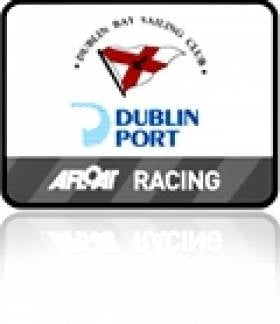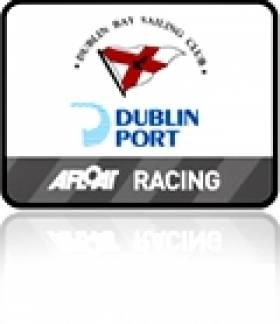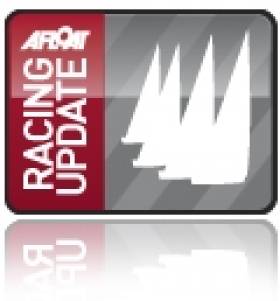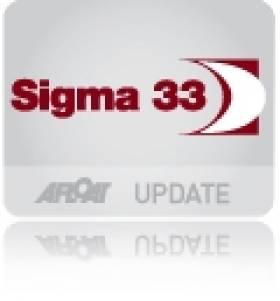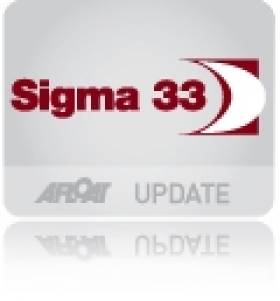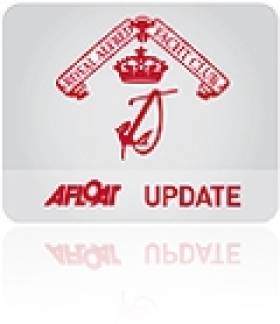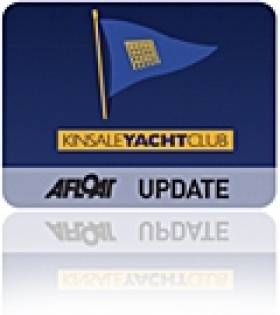Displaying items by tag: Sigma
'Reconnaissance' Wins Fenit to Dingle Race
Peadar O'Loughlin's Sigma 33 Reconnaissance was the overall winner of Tralee Bay Sailing Club's race from Fenit to Dingle this October but only after a great comeback in the last two miles of this County Kerry race.
The first boat in was Galileo, with Reconnaissance hot in his tail and Jaguar not far behind either, with Rooster coming in shortly afterwards. Abandon Office, Powder Monkey and Ridire Ban (previous class winner in Dun Laoghaire - Dingle race) retired. On corrected time, first place in IRC went to the Sigma 33
-Reconnaissance, having made a great comeback to steal it from Jaguar in the last two miles.
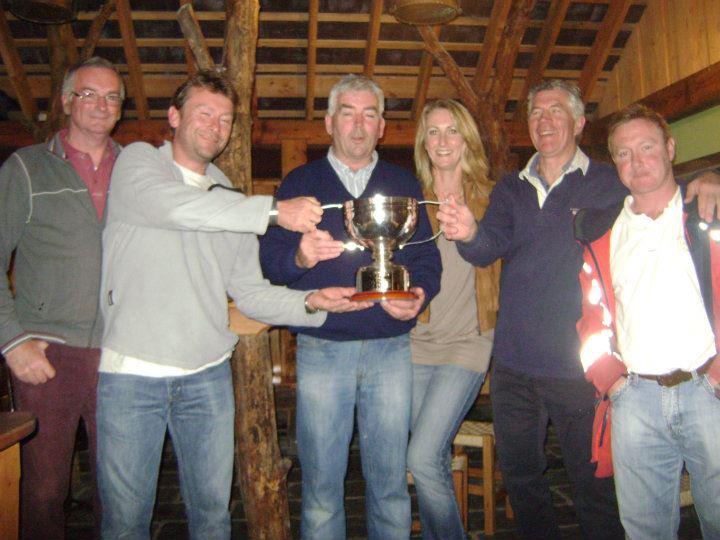
Lifting the O'Connell Cup, the last feature race of the Tralee Bay Sailing Club season. The Cup was Sponsored by Finbar O'Connell Jewellers, Tralee and was won by Reconnaissance, a Sigma 33, owned by Peadar O'Loughlin and crewed by Brian O'Sullivan, Frances Clifford, Fergus Kelliher, Kieran Kelliher, John O'Mahony and Eoin Nolan.
This was the last feature race in the 2011 Tralee Bay Sailing Club calendar. The October series continues 'til the end of the month, and an End of Season Party will be held on the last weekend of the month, after racing that day.
Matt Davis is September's Sailor of the Month
The welcome revival of the offshore racing programme in the Irish Sea has been steered by Peter Ryan of the National Yacht Club in Dun Laoghaire, but without the enthusiastic crew like the Skerries squad, it just wouldn't happen.
Apart from the continuous effort of keeping a frontline offshore racer and all her equipment in sound working order, the demands on personnel for time in this crowded era can be quite exceptional. The logistics are formidable, as the regular cross channel ISORA programme is based on a willingness to alternate between starting points on the Welsh and Irish coast.
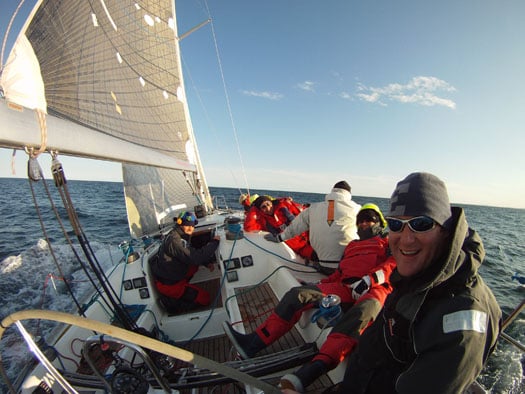
Matt Davis and crew on board Raging Bull in one of this year's ISORA races. Photo: Brian Carlin
For boats heading for an away start, it often involves an overnight passage beforehand. In the case of Raging Bull, all starts are away events, as the programme does not as yet take in Skerries. But we can hope that this will change in the future, as the nucleus of a Fingal offshore racing group develops around the Davis success.
With the summer of 2011's uneven weather, Raging Bull's crew had to be fit and ready to take full advantage of their boat's proven ability in rugged weather, while at the same time managing to turn in a respectable performance in light airs.
For the first time, the biennial Dun Laoghaire-Dingle race was recognized as an ISORA event, and Davis and his crew revelled in it. For much of the race they were the only boat mounting a significant challenge to the pace setter, Martin Breen's Reflex 38 Galway Harbour. Though the Skerries boat had to be content with the runner-up slot to the Galway boat in Dingle, they were first of all the ISORA participants, a top score which stood well to them when they continued with the Irish Sea programme right up until mid-September. Despite the limited size of the harbour, the maritime spirit of Skerries is manifesting itself in many areas of sailing, and Matt Davis's achievement is typical of the special Fingal fervour.
More on Matt's 2011 victory in Autumn Afloat magazine out next week!More ISORA News here
Maguire's 'Gwili Two' Wins Penultimate Sigma Race
BENETEAU 31.7 Echo - 1. Kernach (Eoin O'Driscoll), 2. Fiddly Bits (Kevin Byrne et al), 3. Magic (D.O'Sullivan/D.Espey)
BENETEAU 31.7 - 1. Prospect (Chris Johnston), 2. Bluefin Two (M & B Bryson), 3. Magic (D.O'Sullivan/D.Espey)
CRUISERS 0 - 1. Lively Lady (Derek Martin), 2. Tsunami (Vincent Farrell)
CRUISERS 0 Echo - 1. Tsunami (Vincent Farrell), 2. Lively Lady (Derek Martin)
CRUISERS 1 Echo - 1. Something Else (J.Hall et al), 2. Adrenalin (Joe McDonald), 3. Xtravagance (Colin Byrne)
CRUISERS 1 - 1. Something Else (J.Hall et al), 2. Jalapeno (Dermod Baker et al), 3. Indecision (Declan Hayes et al)
CRUISERS 2 - 1. Jawesome 11 (V.Kennedy/M.Dyke), 2. Peridot (Jim McCann et al), 3. Bendemeer (L Casey & D Power)
CRUISERS 2 Echo - 1. Peridot (Jim McCann et al), 2. Frolix (Noreen Tighe), 3. Graduate (D O'Keeffe)
CRUISERS 3 Echo - 1. Saki (Paget McCormack et al), 2. Cri-Cri (P Colton), 3. Pamafe (Michael Costello)
CRUISERS 3 - 1. Supernova (K.Lawless et al), 2. Cri-Cri (P Colton), 3. Asterix (Counihan/Meredith/Bushell)
DRAGON - 1. Phantom (D.Williams/P.Bowring), 2. Susele (Michael Halpenny), 3. Scorcher (G Purcell)
FLYING FIFTEEN Race 1- 1. Rollercoaster (Tom Murphy), 2. The Gruffalo (Keith Poole), 3. Fflogger (Alan Dooley)
FLYING FIFTEEN Race 2- 1. The Gruffalo (Keith Poole), 2. Rollercoaster (Tom Murphy), 3. Snow White (Frank Burgess)
GLEN - 1. Pterodactyl (R & D McCaffrey), 2. Glenroan (Terence Moran), 3. Glenshesk (L.Faulkner et al)
IDRA 14 FOOT Race 1- 1. Dunmoanin (Frank Hamilton), 2. Dart (Pierre Long), 3. Doody (J.Fitzgerald/J.Byrne)
IDRA 14 FOOT Race 2- 1. Sapphire (Lorcan O'Sullivan), 2. Dunmoanin (Frank Hamilton), 3. Dart (Pierre Long)
MERMAID Race 1- 1. Jill (P.Smith/P.Mangan), 2. Kim (D Cassidy), 3. Aideen (B.Martin/D.Brennan)
MERMAID Race 2- 1. Jill (P.Smith/P.Mangan), 2. Kim (D Cassidy)
RUFFIAN 23 - 1. Diane ll (Bruce Carswell), 2. Ruff N Ready (Ann Kirwan et al), 3. Ruffles (Michael Cutliffe)
SHIPMAN - 1. Whiterock (Henry Robinson), 2. Invader (Gerard Glynn), 3. Macro One (Joseph Murray)
SIGMA 33 - 1. Gwili Two (D.Clarke/P.Maguire), 2. Pippa lV (G.Kinsman/K.Blake/M.O'Brien), 3. White Mischief (Timothy Goodbody)
SQUIB Race 1- 1. Kookaburra (P & M Dee), 2. Little Bird (N Barnwell), 3. Why Not (Derek & Jean Jago)
SQUIB Race 2- 1. Why Not (Derek & Jean Jago), 2. Nimble (Brian O'Hare), 3. Tais (Michael O'Connell)
WHITE SAIL CRUISERS Echo- 1. Coumeenole (Bill Kavanagh), 2. The Great Escape (P & D Rigney), 3. Act Two (Michael O'Leary et al)
WHITE SAIL CRUISERS - 1. Act Two (Michael O'Leary et al), 2. Calypso (Howard Knott), 3. Zephyr (R Cahill-O'Brien)
Supernova to Contest MGM Sponsored DBSC Cruiser Challenge
July's Volvo Dun Laoghaire Regatta Boat of the week, Supernova, will be in action again this weekend in the Cruisers III East Coast championships. The annual fixture is being raced as part of tomorrow's DBSC Cruiser Challenge sponsored by MGM boats, Dún Laoghaire.
Entries for the Challenge stand at 70 to date and remain open for the three day event run by Dublin Bay Sailing Club.
The DBSC Cruiser Challenge is open to Cruisers 0, 1, 2 and 3, Sigma 33s and 31.7s, who will also compete for their national championships during the event.

VDLR Champion Supernova is in action again on Dublin Bay tomorrow
Pat Shannon, vice-commodore of DBSC, says that as well as boats from the main Dún Laoghaire waterfront clubs, DBSC has invited boats from Howth, England and the Isle of Man to compete. "Last year we had 80 boats and we expect something similar. We're running it over the UK bank holiday so we might get those boats," says Pat. DBSC also welcomes Cruisers 3 to the event, who are taking part for the first time. (The Cruiser Challenge will also incorporate this year's Cruisers 3 East Coast Championships.)
This year the National Yacht Club is the host club for the event. Hal Bleakley is the race officer on committee boat, MacLir, and Henry Leonard is race officer on Spirit Of The Irish. NYC sailing manager Olivier Prouvier will coordinate activities on the water.
The organisers also plan plenty of fun after racing, with live music and barbecues in the NYC and a party for the 31.7 nationals in the National Yacht Club on Saturday night.
The main organisers are DBSC commodore Tony Fox, vice-commodore Pat Shannon, rear-commodore Chris Moore and honorary secretary Donal O'Sullivan, assisted by a team of around 28 volunteers. "We're always very grateful to the volunteers, they're the greatest resource we have," says Pat. "We have all the equipment, the greatest resource is the people who help out."
Pat adds that there are great prizes this year – half model yachts, made by Marine Model Makers of Wicklow. "They are very special, so it's worth entering," he says.
The entry fee for each boat is €105 with a reduced fee of €80 for entries received before 12th August.
More Mischief on Dublin Bay
National Sigma 33 Champion White Mischief was up to its old tricks winning races on Dublin Bay last night. The Royal Irish yacht sailed by Timothy Goodbody beat Paddy Maguire's Gwili Two. Third was Enchantress (Michael Larkin et al). Full results for last night's DUBLIN PORT Dublin Bay Sailing Club Results (21 JULY 2011) are below:
BENETEAU 31.7 Echo- 1. Attitude (D.Owens/T.Milner), 2. Thirty Something (Gerry Jones et al), 3. Avalon (R.Conan/J.Fox)
BENETEAU 31.7 - 1. Attitude (D.Owens/T.Milner), 2. Thirty Something (Gerry Jones et al), 3. Prospect (Chris Johnston)
CRUISERS 0 - 1. Wow (George Sisk), 2. Tsunami (Vincent Farrell)
CRUISERS 1 Echo - 1. Jedi (Sarratt/Austin/McGuinness), 2. Xtravagance (Colin Byrne), 3. Aztec 3 (Peter Beamish)
CRUISERS 1 - 1. Xtravagance (Colin Byrne), 2. Jedi (Sarratt/Austin/McGuinness), 3. Aztec 3 (Peter Beamish)
CRUISERS 2 - 1. Jawesome 11 (V.Kennedy/M.Dyke), 2. Jester (Declan Curtin), 3. Dick Dastardly (B.Cusack et al)
CRUISERS 2 Echo - 1. Jester (Declan Curtin), 2. Cor Baby (Keith Kiernan et al), 3. Jawesome 11 (V.Kennedy/M.Dyke)
CRUISERS 3 - 1. Jabiru (M & S Renwick), 2. Jammie Dodger (J.H & D.O'Neill), 3. Upd8 (Whelan/McCabe/Carey)
CRUISERS 3 Echo - 1. Jammie Dodger (J.H & D.O'Neill), 2. Jabiru (M & S Renwick), 3. Hyflyer (John Barnard)
DRAGON - 1. Susele (Michael Halpenny), 2. Phantom (D.Williams/P.Bowring), 3. Scorcher (G Purcell)
FLYING FIFTEEN - 1. Flyer (Niall Coleman), 2. As Good As It Gets (Alan Balfe), 3. Mellifluence (Tom Leonard)
RUFFIAN 23 - 1. Nuits St Georges (Alan Kirwan), 2. Ripples (Frank Bradley), 3. Ruff Nuff (D & C Mitchell)
SB3s - 1. Sin Bin (Barry O'Neill), 2. Seriously Bonkers (P Lee/M Cuppage), 3. Flutter (Andrew Algeo)
SHIPMAN - 1. Curraglas (John Masterson), 2. Whiterock (Henry Robinson), 3. Jo Slim (J.Clarke et al)
SIGMA 33 - 1. White Mischief (Timothy Goodbody), 2. Gwili Two (D.Clarke/P.Maguire), 3. Enchantress (Michael Larkin et al)
SQUIB - 1. Pintail (M Muldoon & B Stevens), 2. Glassilaun (D O'Neill), 3. Kookaburra (P & M Dee)
WHITE SAIL CRUISERS Echo - 1. Coumeenole (Bill Kavanagh), 2. Vespucci (S & K O'Regan), 3. Lucy O (Aonghus O hEocha)
WHITE SAIL CRUISERS - 1. Vespucci (S & K O'Regan), 2. Just Jasmin (Philip Smith), 3. Nauti-Gal (J & J Crawford)
Locals were to the fore at the ICRA Nationals when Antix, Allure, Tiger and Xtension were all winners in Cork Harbour this weekend. It was the same on the on the East coast – but only just – when David Gorman and Chris Doorly lifted the Flying fifteen title at their own club. And locals too are in the top ten of the Fireball Worlds in Sligo. Click th links for our photo reviews.
Dublin Bay was the venue for the Royal Alfred's Bloomsday regatta and Colin Byrne's impressive X34 was top of IRC one. On Belfast lough, Dublin visitor Tim Goodbody won the Sigma 33 title (again), nice T-shirt Tim! The Royal St. George tried out the J80s at the club's first ever Family regatta before handing them over for Ireland's first inter county champs.
Volvo Dun Laoghaire regatta approaches, nearly 400 are entered. Are you on the entry list HERE?
We're in the Ocean Race and we're on board with China's Team Sanya. Old friends are best!
And in Olympic Sailing Water Rat says we deserve two medals from Weymouth. Do we? Your views matter. Let us know!
Stand by for our newsletter later this morning!
White Mischief Wins Sigma 33 Title Again
The Hamilton Shipping sponsored event was scheduled over three days but Friday's 37 knot winds put paid to racing that day. However Principal Race Officer Robin Gray's efforts on the Saturday produced five races then and another three on Sunday, making a substantial championship race programme.
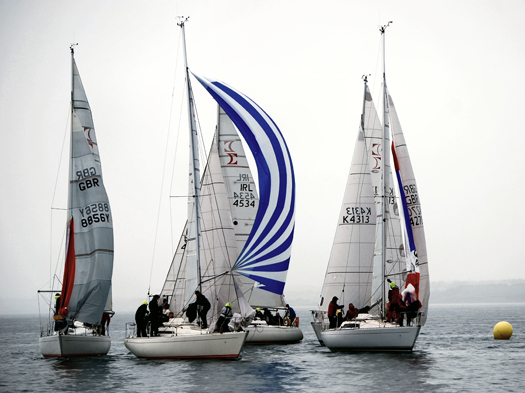
The seventeen strong fleet came from Scotland, Dublin Bay, the Isle of Man, Belfast Lough and Strangford Lough.
Proving that consistency as well as speed pays, Goodbody won only one race but counted scores never over 4th, giving White Mischief a total of 19, seven ahead of runner up, newcomer Stephen Milne and the team on the borrowed Cushendall based Insider. Milne is a member of the Skandia Team GBR Performance Squad as crew for John Gimson in a Star.
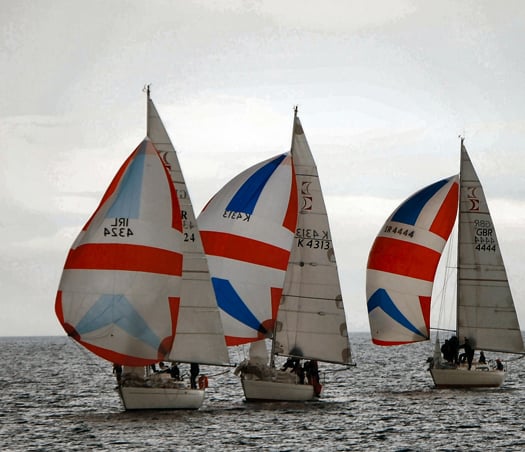
The first and fifth races went to the Scottish boat, Mayrise (James Millar) but a disqualification in Race 7 dropped her from starting third overall on the Sunday to a 6th place finish. Ross Boyd's Mithril from Quoile won Races 2 and 4 and the other Strangford Lough entry, Signet of Kip made up for a disqualification in Race 2 by winning Races 3 and 8. Goodbody took first in Race 7.
At the prize giving Hamilton Shipping's Finance Director Ken Craig admitted that he knew nothing about sailing but was impressed by this competition.

He couldn't be 69!

Hamilton Shipping Finance Director Ken Craig and his wife Tricia with RUYC Rear Commodore Stephen Graham and the crew of White Mischief. Photos by Ken Hunter
Sigma 33s Bound for Belfast Lough
The event, sponsored by Hamilton Shipping, has already attracted yachts from Scotland, Dublin Bay, Isle of Man and Strangford Lough and they will join the locals for eleven races over the three days. Seventeen have entered.
Among the entries is the current champion, Tim Goodbody in White Mischief from the Royal Irish at Dun Laoghaire as well as five boats who took part in the recent Scottish Series including the class winner Donald McLaren in Sigmatic.
Locals gearing up for the competition are great rivals, Blues (Hamilton/Milne) and the Taylor/Sherwood team in Sula as well as Gerry Bell’s Cariad and Chris and Michael Johnston’s Impulz.
There were two windward leeward races on Saturday morning staged for a fleet of seven J109s and six Sigma 33s. Results from Saturday afternoon's regular DBSC racing were then added to the score tally. The full results are: Sigma 33: 1. White Mischief (Tim Goodbody) 2. Rupert Dick Lovegrove 3. Alandra. (John Molloy) J109: 1. Joker (John Maybury) 2. Storm. (P. Dillon) 3. Jalapeno (Dermod Baker).
The second part of the Baily Bowl one design competition will be held next weekend for Dragons, Flying fifteens, Squibs and SB3s, although that sportsboat class says it has not had much local take up for the event to date.
Sovereign's Cup 2005 - Photo Review
Anthony O’Leary’s Corby 35 ‘Antix’ won sailing's Sovereign’s Cup at Kinsale Yacht Club, and Paddy Gregory’s Elan 31 ‘Benola’ the Portcullis Trophy. Eamon Conneely’s Transpac 52 ‘Patches’ was the winner in Division 0 IRC, gaining National Champion title for that Division and the Saab Trophy for IRC.
‘Antix’ was the yacht deemed by the organising committee to have put in the best overall performance under IRC across the four fleets. She and Eamon Crosbie’s ‘Voodoo Chile’ had quite a duelling match in Division 1, with ‘Antix’ emerging as National Champion. ‘Benola’ finished first overall in both IRC and Echo in Division 2, winning double National Championship titles. Neil White’s Sigma 400 ‘Barafundle of Mumbles’ was the Division 1 winner and Champion.
Photos of the 2007 event by Bob Bateman BELOW:






























